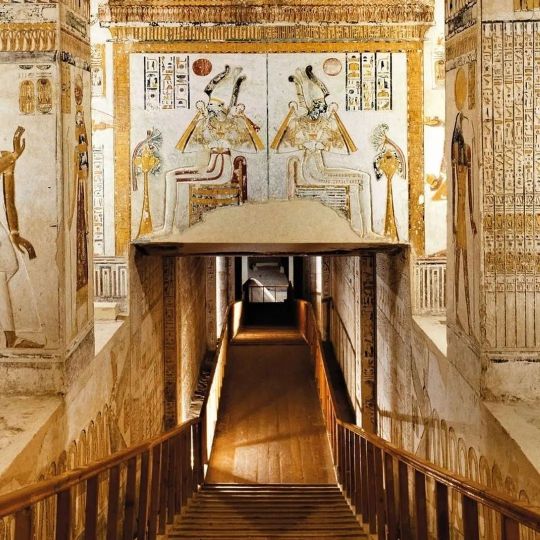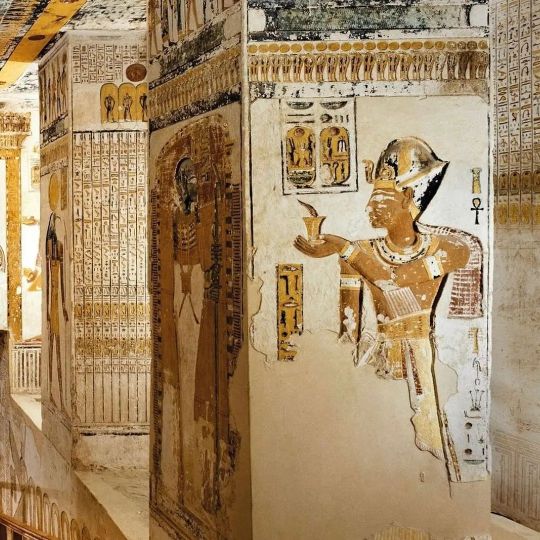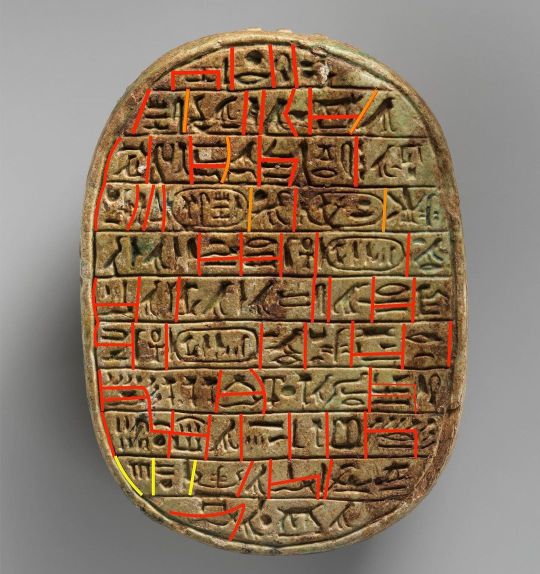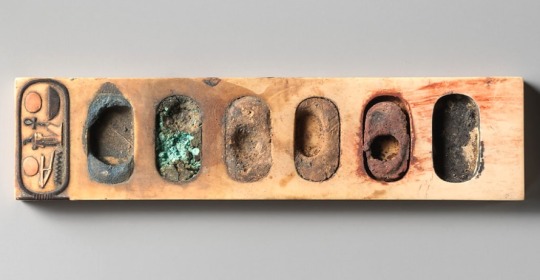#Nebmaatre
Text

Ancient Egyptian faience amulet in the form of a cartouche of Nebmaatre, throne name of Amenhotep III "the Great" (r. ca. 1390-1352 BCE). Found in Amenhotep's tomb (WV 22) in the Valley of the Kings; now in the Metropolitan Museum of Art.
#art#art history#ancient art#Egypt#Ancient Egypt#Egyptian art#Ancient Egyptian art#18th Dynasty#New Kingdom#Amenhotep III#Nebmaatre#jewelry#jewellery#amulet#faience#cartouche#hieroglyphics#Metropolitan Museum of Art
555 notes
·
View notes
Text
Look, if none of you are reading Life's Great Lie, a DP X MCU crossover, I highly recommend you do because things are approaching epic territory.
“How dare you,” hissed Loki, reasserting his control of Phantom with a twist of his staff.
“How dare you,” snapped the dark-skinned boy. “He’s mine. He was mine first, and you have no right to him!”
“I have every right! I am a god, you pathetic sorcerer!” Loki called on his magic, and on Phantom’s blanketing the sand with ice.
“You?” sneered the boy, tilting his chin up. “You think you are a god? I am Nebmaatre Djedamun, called Duulaman! I am the Son of Ra! The Son of the Sun! I have lived and walked through the Duat and returned, as Osiris! Who are you, foreigner, to take what is mine?”
The ice beneath Loki began to steam, and the sun burned down from directly overhead, a position it should not be in under any circumstances at this latitude on Earth.
So. That was how it was going to be, was it?
“I am Loki Laufeyson, god of mischief and rightful king of Asgard.” He bared his teeth and called up his armor, scepter growing into a full staff, the false sand desert morphing into an equally false vista of ice. “Let’s see if you’re worth my time. Human.”
127 notes
·
View notes
Text

Painter's Palette Inscribed with the Name of Amenhotep III ca. 1390–1352 B.C.
Source: Metropolitan Museum of Art
Carved from a single piece of ivory with wells for six different pigments. It is inscribed with the throne name of Amenhotep III, Nebmaatre, and the epithet "beloved of Re."
7 notes
·
View notes
Text

Colossal hand from a statue, with the cartouche of Amenhotep iii (Nebmaatre)
#Amenhotep iii#new kingdom#pharaoh#Egyptian pharaoh#Egypt#ancient Egypt#Egyptian#ancient Egyptian#Kemet#Kemetic#Kemeticism#Karnak#temple
1 note
·
View note
Text

Egyptian pot held in the Louvre
Inscription on vase reads from center line, then left, then right, top to bottom: center :
The good god, Nebmaatre, given life; left: the son of Re, Amenhotep, Ruler of (Wast-Uast)(Thebes), eternally; right: the king’s great wife, Tiye
#ancient egypt#egyptian pottery#egyptian mythology#ancient history#history#egyptian hieroglyphs#egyptian gods#egyptian afterlife#egyptian art#egyptology#ancient art
343 notes
·
View notes
Photo



The Tomb of Ramessess VI
Ramesses VI Nebmaatre-Meryamun (sometimes written Ramses or Rameses, also known under his princely name of Amenherkhepshef C) was the fifth ruler of the Twentieth Dynasty of Egypt. He reigned for about eight years in the mid-to-late 12th century BC and was a son of Ramesses III and queen Iset Ta-Hemdjert. As a prince, he was known as Ramesses Amunherkhepeshef and held the titles of royal scribe and cavalry general. He was succeeded by his son, Ramesses VII Itamun, whom he had fathered with queen Nubkhesbed.
After the death of the ruling pharaoh, Ramesses V, who was the son of Ramesses VI's older brother, Ramesses IV, Ramesses VI ascended the throne. In the first two years after his coronation, Ramesses VI stopped frequent raids by Libyan or Egyptian marauders in Upper Egypt and buried his predecessor in what is now an unknown tomb of the Theban necropolis. Ramesses VI usurped KV9, a tomb in the Valley of the Kings planned by and for Ramesses V, and had it enlarged and redecorated for himself. The craftsmen's huts near the entrance of KV9 covered up the entrance to Tutankhamun's tomb, saving it from a wave of tomb robberies that occurred within 20 years of Ramesses VI's death. Ramesses VI may have planned and made six more tombs in the Valley of the Queens, none which are known today.
Egypt lost control of its last strongholds in Canaan around the time of Ramesses VI's reign. Though Egyptian occupation in Nubia continued, the loss of the Asiatic territories strained Egypt's weakening economy and increased prices. With construction projects increasingly hard to fund, Ramesses VI usurped the monuments of his forefathers by engraving his cartouches over theirs. Yet he boasted of having "[covered] all the land with great monuments in my name [...] built in honour of my fathers the gods". He was fond of cult statues of himself; more are known to portray him than any Twentieth-Dynasty king after Ramesses III. The Egyptologist Amin Amer characterises Ramesses VI as "a king who wished to pose as a great pharaoh in an age of unrest and decline".
The pharaoh's power waned in Upper Egypt during Ramesses VI's rule. Though his daughter Iset was named God's Wife of Amun, the high-priest of Amun, Ramessesnakht, turned Thebes into Egypt's religious capital and a second center of power on par with Pi-Ramesses in Lower Egypt, where the pharaoh resided. In spite of these developments, there is no evidence that Ramessesnakht's dynasty worked against royal interests, which suggests that the Ramesside kings may have approved of these evolutions. Ramesses VI died in his forties, in his eighth or ninth year of rule. His mummy lay untouched in his tomb for fewer than 20 years before pillagers damaged it. The body was moved to KV35 during the reign of Pinedjem I, and was discovered in 1898 by victor Loret.
#The Tomb of Ramessess VI#Twentieth Dynasty of Egypt#Valley of the Kings#pharaoh#ruler#history#history news#ancient historuy#ancient civilizations#ancient egypt#grave#ancient grave#art#artist#art work#afterlife#paintings#drawings#hieroglyphs#egyptian hieroglyphs
159 notes
·
View notes
Photo

Ring: Nebmaatre (Amenhotep III), Ancient Egyptian, -1390, Art Institute of Chicago: Arts of Africa
The Art Institute of Chicago
Size: W. 1 cm (3/8 in.); diam. 2.2 cm (7/8 in.)
Medium: Faience
https://www.artic.edu/artworks/141175/
10 notes
·
View notes
Note
I understand that you might be busy, but could you help me with the meaning behind Amenhotep III's name Nimmureya?
Certainly! "Nimmureya" is the Akkadian rendition of Amenhotep's prenomen "Nebmaatre", "Possessor of the ma'at of Re". He was referred to as Nimmureya in the Amarna letters sent to him by Tušratta, the Mitanni king. So it's a foreign way of spelling his prenomen, similar to how the Greeks rendered Amenhotep as Amenophis.
Let me know if you've got more questions about it!
19 notes
·
View notes
Photo

Scarab Commemorating the Construction of an Artificial Lake (ca. 1390–1352 B.C.) New Kingdom During Amenhotep's reign, a series of large, glazed steatite scarabs were issued commemorating events in the king's life 𓇓𓏏𓈖𓋹 “nsw(t)-ˁnḫ”. This commemorative scarab records the completion of an artificial lake 𓈙𓏤𓈅 “š” constructed 𓂓𓏏𓀋 “k3.t” by Amenhotep III (𓇋𓏠𓈖𓏛𓋾𓋆) “ı͗mn-ḥtp-ḥk3-w3s.t” ‘Amun is Content, Ruler of Thebes” for his great-royal-wife 𓇓𓈞𓏏 “ḥm.t-n(y)-sw.t”, Queen Tiye (𓍘𓏭𓇌𓁐) “tı͗-y”. The scarab also refers to the boat on the lake as the Dazzling Aten 𓇋𓏏𓈖𓇳𓋴𓍘𓎛𓈖𓋣 “ı͗tn stḥn” (sundisk god), which harks to the future pharaoh Akhetaten who made the Aten, the only state god. The main inscription reads: “Regnal Year 11 under the majesty of Horus, the Strong Bull Appearing in Truth, Two Ladies, Who Established the Laws and Pacifies the Two Lands, Horus of Gold, Strong of Arm who Smites the Asiatics, King of Upper and Lower Egypt Nebmaatre, Son of Re, Amenhotep Ruler of Thebes given life, the great royal wife Tiye, may she live, whose father's name is Yuya and whose mother's name is Tjuyu. His majesty commanded the making of a basin for the great royal wife Tiye, may she live, in her town of Djarukha. Its length is 3700 (cubits) and its width is 700 (cubits.) (His Majesty) celebrated the opening of the lake in the third month of the Akhet season, day 16. The procession of his majesty in the royal barge Aten-Tjehen (the dazzling sun disk) was in it” (photo 1-2) Another text is inscribed on the front reads: The living perfect god, Nebmaatre (Amenhotep III), beloved of Horus of Buhen live (photo 3-4). Finally, two inscriptions in the triangles formed by the legs and base bears the names of the king and the queen: The perfect god, lord of the two lands, Nebmaatre (Amenhotep III) given life (photo 5-6). The royal wife Tiye, may she live (photo 7-8). #Ancienthistory #historyfacts #historylovers #ancientegypt #hieroglyphics #ägypten #egyptologist #egyptianhistory #egyptology #hieroglyphs #egypte #egyptians #egitto #埃及 #مصر #egipto #이집트 #art #culture #history #amenhotepiii #scarab #lake #aten #boat #egyptianqueen https://www.instagram.com/p/CSPOVz3LyDw/?utm_medium=tumblr
#ancienthistory#historyfacts#historylovers#ancientegypt#hieroglyphics#ägypten#egyptologist#egyptianhistory#egyptology#hieroglyphs#egypte#egyptians#egitto#埃及#مصر#egipto#이집트#art#culture#history#amenhotepiii#scarab#lake#aten#boat#egyptianqueen
7 notes
·
View notes
Text

La tavolozza di un pittore dell'Antico Egitto, risalente a 3370 anni fa circa, fatta in un pezzo singolo di avorio con 6 ovali con i colori: blu, verde, marrone, giallo, rosso e nero, fatti con pigmenti minerali di vari tipi.
L'iscrizione nel ovale in alto invece, tradotta sta per: Amenhotep III, Nebmaatre, e poi l'epiteto: "amato dal re".
Fonte: https://www.metmuseum.org/art/collection/search/544518
26 notes
·
View notes
Photo

Commemorative Lion Hunt Scarab of Amunhotep III, ca. 1390-1352 B.C.E., Brooklyn Museum: Egyptian, Classical, Ancient Near Eastern Art
Glazed steatite scarab of Amenhotep III. On the base of the scarab is inscribed the following text: “Live Horus, The Mighty- Bull in truth, The Nebty Establisher- of- Laws, he who quiets the Two Lands, The Horus of Gold Great- for- Strength, the smiter of the asiatics, the King of Upper and Lower Egypt Nebmaatre, Son of Re Amenhotep, Ruler of Thebes, may he be given life, (and) the King’s Wife Tiy, give life. Statement of lions which (the King) brought back by means of his own arrows (in the period of) Year 1 to Year 10: 10 (2) lions.” The scarab has notched clypeus, and a prothorax which curves towards the rear. The legs are given in relief, and the piece is pierced from front to rear for suspension. There is a triangle incised on each wing case. Condition: Many chips on back and base; bluish green glaze only preserved in spots.
Size: 1 5/16 x 2 5/16 x 3 7/16 in. (3.4 x 5.8 x 8.7 cm)
Medium: Steatite, glaze
https://www.brooklynmuseum.org/opencollection/objects/117125
3 notes
·
View notes
Photo

Cartouche of Amenhotep III A detail of a wall carving depicts the royal cartouche of Amenhotep III (Nebmaatre, The Lord of Truth is Re). Tomb of Kheruef (TT192), El-Assasif, West Thebes. Kheruef, also called Senaa, was a Steward to the Great Royal Wife Tiye, during the reign of King Amenhotep III. #egyptology_misr #Egypte #Agypten #Egipt #Egipto #Egitto #Египет #مصر #मिस्र #エジプト #埃及 #Egypten #Visit_Egypt #discover_Egypt #Experience_Egypt #diving #socialmedia #egypt #iloveegypt #luxor #karnak #mylifesamovie #mylifesatravelmovie #travelblog #travelblogger #solotravel #wanderlust #gopro #egyptology #ancientegypt (at Tomb Of Kheruef (TT192)) https://www.instagram.com/p/CO5Scu8FquL/?igshid=17hmw59237mli
#egyptology_misr#egypte#agypten#egipt#egipto#egitto#египет#مصر#मिस्र#エジプト#埃及#egypten#visit_egypt#discover_egypt#experience_egypt#diving#socialmedia#egypt#iloveegypt#luxor#karnak#mylifesamovie#mylifesatravelmovie#travelblog#travelblogger#solotravel#wanderlust#gopro#egyptology#ancientegypt
3 notes
·
View notes
Photo

Artist's palette, 1390-1353 BC e., at the Metropolitan Museum of Art, New York. This painter's palette was carved from a single piece of ivory. Six oval wells contain cakes of pigments including blue, green, brown, yellow, red, and black. The oval cartouche at one end encircles the throne name of Amenhotep III, Nebmaatre, and the epithet "beloved of Re."
1 note
·
View note
Text
Foreign leaders liked Amenhotep (like, genuinely, not diplomatically) so much. Amenhotep and various foreign leaders called each other “my brother, my friend”
Tushratta, an Akkadian leader who became his father-in-law was especially fond of him so you see stuff like
To Nimmureya*, my brother, my son-in-law, whom I love and who loves me from Tushratta the king of Mitanni, your father-in-law, your brother, who loves you...as now I love my brother, and as now my brother loves me... all the things my brother wishes in his heart [the gods] will make true... I will have with my brother a relationship full of love... we are both of one mind and love one-another - letter from Tushratta about marriage and friendship (it’s a really long letter. he says “i love you, man” a LOT)
When Amenhotep died, Tushratta was so grief-stricken that he apparently refused food and water and pleaded with the gods to die in his place.
When I heard that my brother Nimmureya had gone to his fate, on that day I sat down and wept. On that day I took no food, I took no water. I grieved, saying “let me be dead, or let 10,000 from my country be dead, but let my brother Nimmureya be alive and well for as long as the earth ” - Letter from Tushratta to Queen Tiye
(We have a lot of letters between Egypt and her neighbours from the reigns of Amnehotep III, Akhenaten, and Tutankhamum in a fair-massive corpus known as The Amarna Letters. Amenhotep is called brother a lot. By, like, everyone)
*Amenhotep’s throne-name was Nebmaatre. Nimmureya is the Akkadian rendering of it.
#tushratta and amenhotep were very cute#but like seriously everybody called him my brother whom i love#NOBODY calls akhenaten 'my brother whom I love' after he ascends to the throne#like tushratta? he calls akhenaten 'my brother also as nimmureya lives on' in the letter to tiye#but then like#just stops#presumably because he realises akhie is a fuckin' dick
33 notes
·
View notes
Text
#ancient societies were so fucking weird #why would you wanna bone next to your great grandparents bodies
@mailidhonn Shaft burials! Your grandparents are still in the ground, and probably like 20ft down, with a little stele to mark where(ish). You however are boning in the chapel above the shaft burial and therefore free of grandma’s judgement sETH’S TESTICLES THAT IS YOUR COUSIN NEBMAATRE, STOP THAT AT ONCE.
66 notes
·
View notes
Link
Ramesses VI Nebmaatre-Meryamun was the fifth pharaoh of the Twentieth Dynasty of Egypt (mid to late 12th century BC). He was buried in Egypt’s Valley of the Kings, in a tomb now known as KV9.
Earlier this year, the Egyptian Tourism Authority released an incredible 3D virtual tour of the tomb and the detail and artistry is astounding. Below you will find some screen shots from the virtual tour but be sure to explore it for yourself here.
0 notes